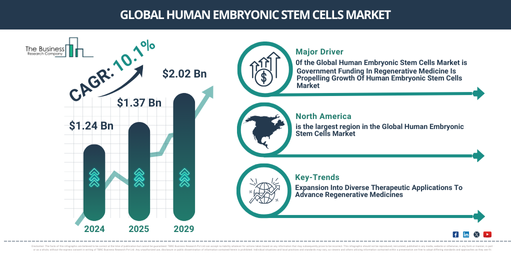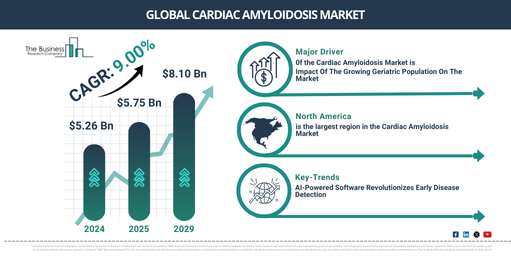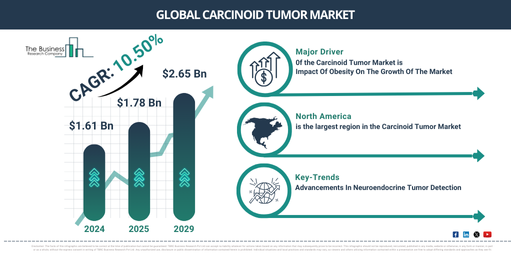Unlocking the Future of the Human Embryonic Stem Cells Market: Growth Rate, Key Trends, and Opportunities for 2025-2034
Updated 2025 Market Reports Released: Trends, Forecasts to 2034 – Early Purchase Your Competitive Edge Today!
Analyzing the Growth Rate of the Human Embryonic Stem Cells Market: What’s the Expected CAGR for the Next Decade?
The market for human embryonic stem cells has seen a significant expansion in recent times. The projected growth is from $1.24 billion in 2024 to $1.37 billion in 2025, with a compound annual growth rate (CAGR) of 10.5%. Factors such as funding and investment, regulatory clearances, increased public consciousness, the rise in regenerative medicine, and a wider scope of clinical applications have all contributed to this unprecedented growth in the historical timeline.
The market for human embryonic stem cells is projected to experience a rapid expansion over the coming years. By 2029, it is predicted to reach $2.02 billion, reflecting a compound annual growth rate (CAGR) of 10.1%. This increase throughout the forecast period is connected to a rise in cell therapy production facilities, growing interest in regenerative therapies, heightened occurrence of cardiac and malignant diseases, advancements in stem cell biology research, and an improved understanding of the therapeutic potential of stem cells. Key trends forecasted for the period include leaps in regenerative medicine, a widening emphasis on personalized medicine, expanding uses in drug discovery and toxicology, technological breakthroughs, and a surge in biobanking.
Which Macro and Microeconomic Factors Are Accelerating the Growth of the Human Embryonic Stem Cells Market?
The surge in the human embryonic stem cells market is anticipated to be fuelled by government capital allocation towards the progression of regenerative medicine. With its primary focus on mending, replacing, or regenerating damaged tissues or organs, regenerative medicine plays a vital role in reinstating the body’s normal function. There has been a noticeable rise in government investment in regenerative medicine, motivated by factors such as increased chronic disease rates, advancements in stem cell research, and a promising potential for innovative treatments to enhance patient results. Human embryonic stem cells find significant use in regenerative medicine, serving as potential therapies for mending or replacing damaged tissues and organs within the body. For instance, the stem cell network received a funding of $45 million over three years, from 2022-23, as disclosed by the Government of Canada in May 2022. This investment was part of the Budget 2021’s allocation to strengthen stem cell and regenerative medicine research. Hence, the government’s investment in the growth of regenerative medicine is a key driver for the expansion of the human embryonic stem cells market.
Explore Comprehensive Insights Into The Global Human Embryonic Stem Cells Market With A Free Sample Report:
https://www.thebusinessresearchcompany.com/sample.aspx?id=16086&type=smp
What Are the Leading Organizations Impacting the Human Embryonic Stem Cells Market’s Growth?
Major companies operating in the human embryonic stem cells market are:
• Thermo Fisher Scientific Inc._x000D_
• Takeda Pharmaceutical Company Limited_x000D_
• Gilead Sciences Inc._x000D_
• Merck KgaA_x000D_
• Astellas Pharma Inc._x000D_
What Are the Most Prominent Trends Driving Change in the Human Embryonic Stem Cells Market?
Major corporations in the human embryonic stem cell sector are striving to diversify their therapeutic applications, such as using pluripotent stem cells for Parkinson’s disease treatments, to attain a competitive advantage. These pluripotent stem cells are leveraged to create dopaminergic neurons with the intention of substituting missing dopamine-producing neurons and bringing back motor functions. For example, Bayer AG, a pharmaceutical and biotechnology firm based in Germany, set up its first Cell Therapy Manufacturing plant in California in October 2023. An investment of $250 million was made to globally manufacture cell and gene therapies. Initially, this facility will concentrate on producing bemdaneprocel from BlueRock Therapeutics, derived from pluripotent stem cells (PSC) to treat Parkinson’s disease. The factory is equipped with fully electric manufacturing to cater to the manufacturing capacity needs of the regenerative medicine field.
Secure Your Global Human Embryonic Stem Cells Market Report Now for Fast and Efficient Delivery!
https://www.thebusinessresearchcompany.com/report/human-embryonic-stem-cells-global-market-report
Which Segments Play a Crucial Role in the Expansion of the Human Embryonic Stem Cells Market?
The human embryonic stem cells market covered in this report is segmented –
1) By Type: Totipotent Stem Cells, Pluripotent Stem Cells, Unipotent Stem Cells
2) By Product: Regenerative Medicine, Stem Cell Biology Research, Tissue Engineering, Toxicology Testing
3) By Application: Research, Clinical Trials, Other Applications
Subsegments:
1) By Totipotent Stem Cells: Embryonic Totipotent Stem Cells, Induced Totipotent Stem Cells
2) By Pluripotent Stem Cells: Human Embryonic Stem Cells (hESCs), Induced Pluripotent Stem Cells (iPSCs), Embryonic Stem Cell Lines, Conditioned Pluripotent Stem Cells
3) By Unipotent Stem Cells: Somatic Stem Cells, Adult Stem Cells, Tissue-Specific Stem Cells
What Regions Are Leading the Charge in the Human Embryonic Stem Cells Market?
North America was the largest region in the human embryonic stem cells market in 2024. Asia-Pacific is expected to be the fastest-growing region in the forecast period. The regions covered in the human embryonic stem cells market report are Asia-Pacific, Western Europe, Eastern Europe, North America, South America, Middle East, Africa.
What Does the Definition of the Human Embryonic Stem Cells Market Include?
Human embryonic stem cells (hESCs) are pluripotent cells derived from the inner cell mass of a blastocyst, an early-stage embryo. These cells have the unique ability to differentiate into any cell type in the human body, making them incredibly valuable for various research and therapeutic purposes. The primary uses of hESCs includes developing treatments for diseases and injuries by generating healthy tissue and studying the progression and treatment of diseases in a controlled environment.
Browse Through More Similar Reports By The Business Research Company:
Automotive Human-Machine Interfaces Global Market Report 2024
Human Capital Management Global Market Opportunities And Strategies To 2032
https://www.thebusinessresearchcompany.com/report/human-capital-management-market
Human Liver Model Global Market Report 2024
https://www.thebusinessresearchcompany.com/report/human-liver-model-global-market-report
About The Business Research Company:
With over 15000+ reports from 27 industries covering 60+ geographies, The Business Research Company has built a reputation for offering comprehensive, data-rich research and insights. Armed with 1,500,000 datasets, the optimistic contribution of in-depth secondary research, and unique insights from industry leaders, you can get the information you need to stay ahead in the game.
Contact us at:
The Business Research Company: https://www.thebusinessresearchcompany.com/
Americas +1 3156230293
Asia +44 2071930708
Europe +44 2071930708
Email us at [email protected]
Follow us on:
LinkedIn: https://in.linkedin.com/company/the-business-research-company
YouTube: https://www.youtube.com/channel/UC24_fI0rV8cR5DxlCpgmyFQ
Global Market Model: https://www.thebusinessresearchcompany.com/global-market-model
Found this article helpful? Share it on:



